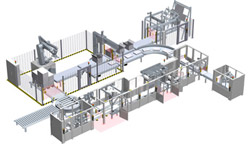
Posted to News on 21st Dec 2017, 10:10
How to adopt modularisation in the Industry 4.0 era
Neil Beaumont of Lenze discusses the challenges and offers some solutions for integration and communications when adopting modularisation, particularly in the context of Industry 4.0.

Modularisation is one of the defining trends of modern machine design. Unlike their monolithic counterparts, modular machines are built from standardised components or sub-systems that can be combined in different ways to perform a range of functions. This can save a lot of time in the planning, design and commissioning of such machines, as well as enabling rapid reconfigurations to be made to meet changing production needs.
Modularisation has therefore enabled machine builders to manage complexity in the mechanical structure of their machines, while modern mechatronic techniques have enabled the machine's mechanical, electronic and software components to be engineered in a co-ordinated manner. By breaking designs down into standard functional units, and developing modules to fulfil those functions, engineers have ready-made solutions to common machine tasks directly to hand.
Benefits and challenges of modularisation
The approach is potentially highly efficient. Functional modules and components can be transferred from one machine variant to another, thereby cutting development costs and enabling new products to be delivered to the market more rapidly. Moreover, modularisation reduces the incidence of faults and quality problems, since much of the new machine's functionality, which resides in its modules, has already been proven in other designs. So far, so good; but modularisation brings its challenges too. Designers may have the freedom to pick different module kits, but each standard module has fixed functionality, making the approach a little less flexible than might be desired. There is also the risk of 'over-engineering' a particular machine if the modules available provide more functionality than is actually required, which has cost penalties for the OEM.
To avoid this particular trap, a more scalable approach is needed; for example, making 'families' of modules available that fulfil the same function but at different sizes or capacity levels. Optimising such modules is tricky, however: too many options mean excess cost and management complexity, while too few means the right solution is not always available. And machines built from identical or similar module kits mean that OEMs find it difficult to differentiate their products from those of their competitors, as they tend to look and work similar to each other.
Industry 4.0
And then, along comes Industry 4.0, bringing further challenges to module design. For machines from different manufacturers to work together seamlessly, interfaces must be programmed uniformly and in compliance with standards, but modules need to retain sufficient flexibility at the software level to meet the requirements of specific machines, applications and users.
Drives and automation technology manufacturers can do much to assist their OEM customers in meeting modularisation goals. That support starts at the hardware level, with the availability of complete, scalable product ranges with a focus on standard components. The adoption of standard communication technologies, which is considered the 'nervous system' of Industry 4.0, aids the integration of components within machines and of machines with each other. On the horizontal level, that means the use of standards such as Ethernet or deterministic buses such as Ethercat. In the vertical direction, it includes PLCopen and the OMAC PackML standard.
The right software offerings are also increasingly critical. Indeed, 92 percent of the OEMs consulted in a survey conducted in 2014 saw their software innovations as providing that all-important competitive advantage. This is an area where the providers of technology to OEMs can also make a real difference.
Take Lenze's FAST application software toolbox as an example. Typically, this comprehensive system development tool eliminates around 80 per cent of the work required to develop control applications from scratch, creating technology modules that can be combined with each other. The system also allows the creation of custom modules to handle user-specific tasks.
Another key challenge in modularisation lies in eliminating the time-consuming and costly software modifications required to create different machine designs. Standardised software structures, such as the Lenze Application Template or the PackML standard, enable this challenge to be overcome. A new program based upon the new machine's individual mechatronic components can be generated using proven machine software modules that can be brought together quickly. The resulting program conforms to a standard that all engineers within the company understand. This, in turn, allows a shared rather than individual responsibility towards the machine code.
The combination of stronger hardware and software integration and greater flexibility is paving the way for a new era of modularisation. The simple functional modules of the past are evolving into sophisticated 'machine modules' that can handle more complex tasks such as winding or product sealing.
Integrating those modules into a complete solution is becoming quicker, easier and cheaper; and that will enable OEMs to focus more of their time, effort and expertise on creating the features that not only set them apart from their competitors but also add value for their customers.
Follow the link for more information about Lenze products and how they can help machine builders in the Industry 4.0 era.






























